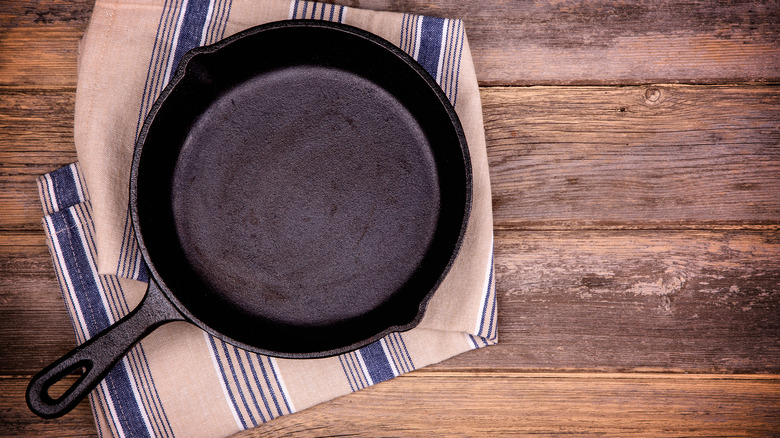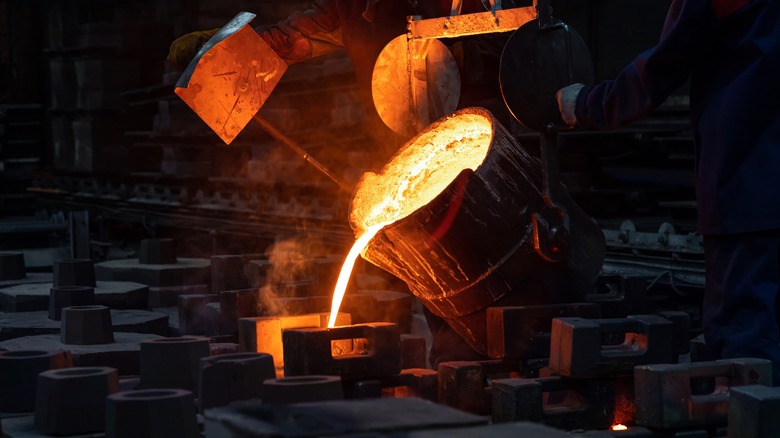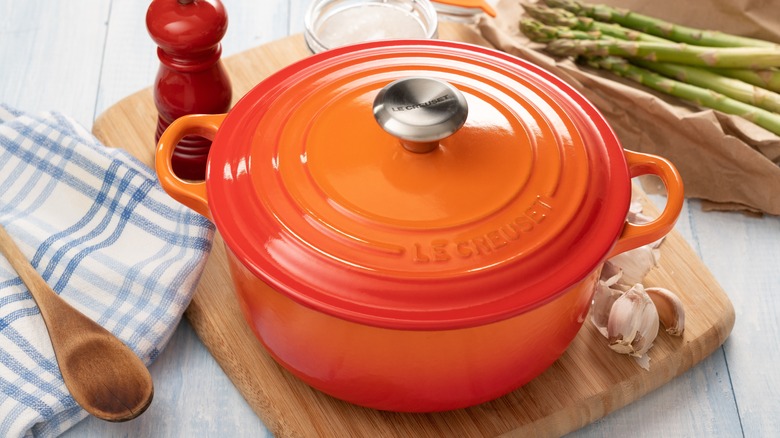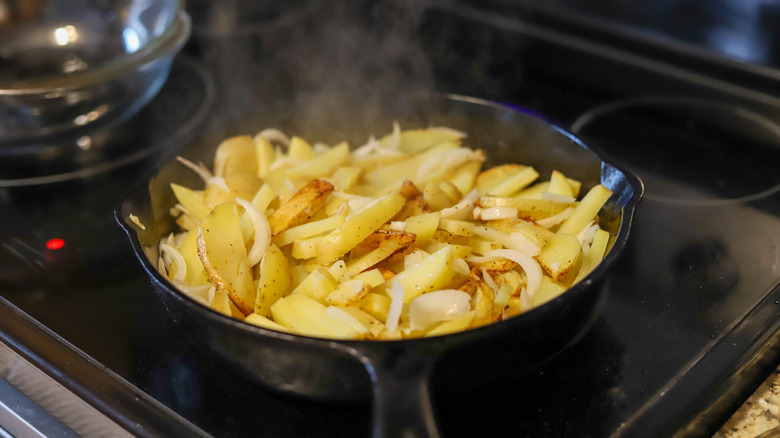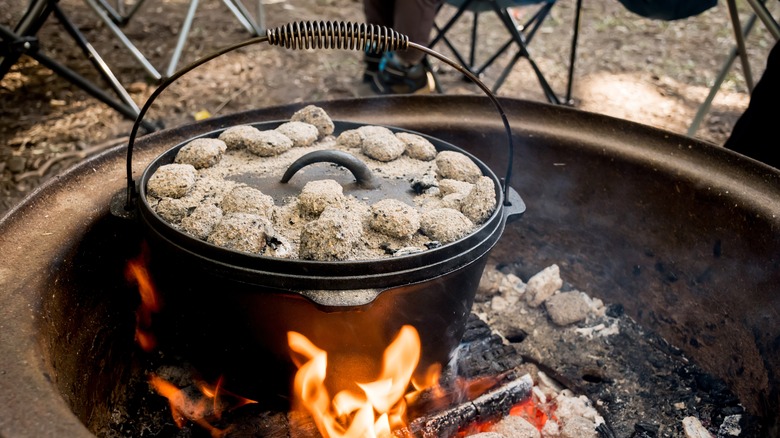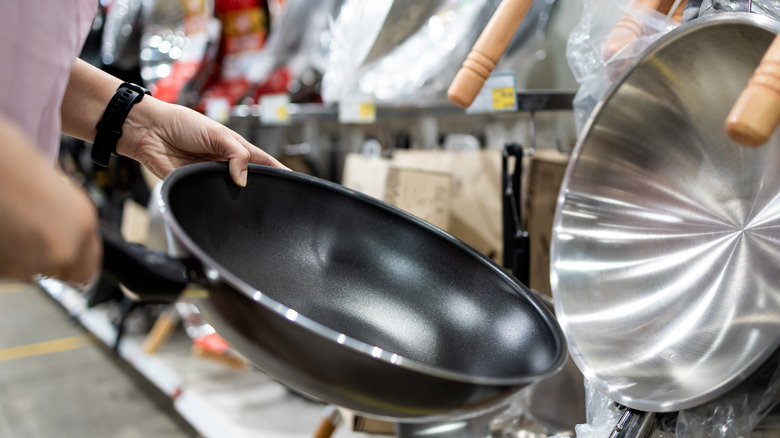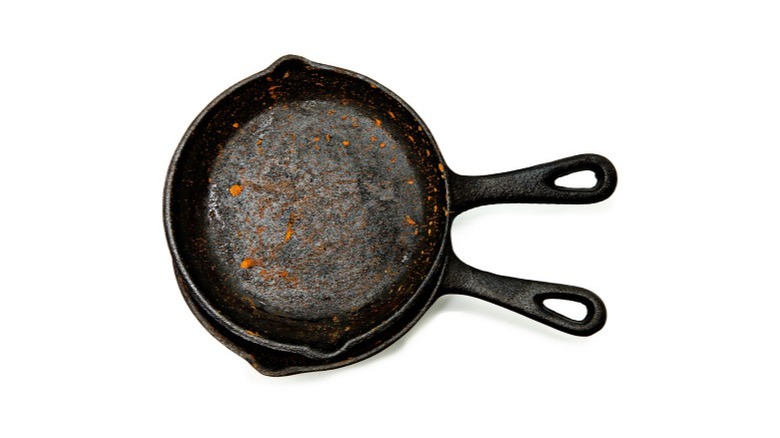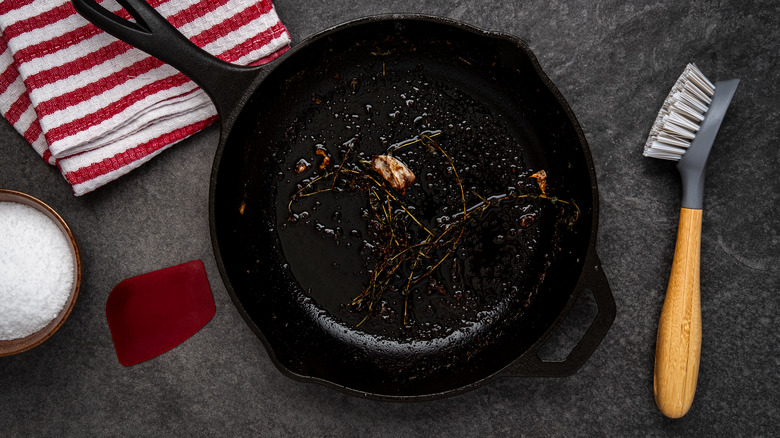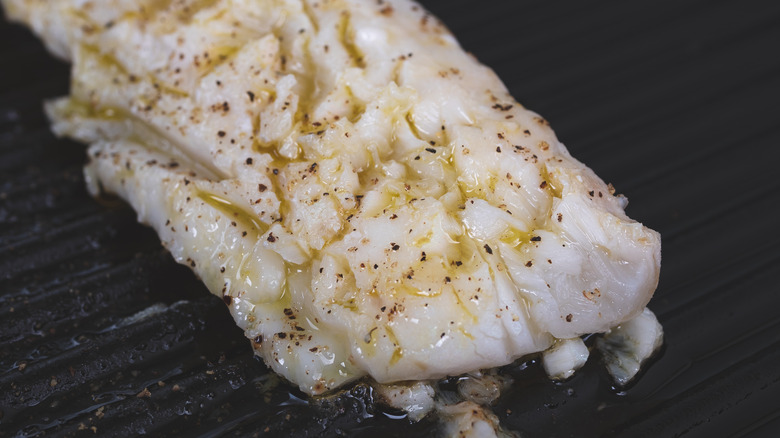The Ultimate Guide To Cast-Iron Cookware
Cast iron is one of the classic cookware options. The first known uses of cast iron cookware date back to China in the 6th century BCE. Since then, cast iron has spread across the globe. Over time it gained more and more popularity, first as a material used to make kettles, then later as pots and pans. During the 1700s especially, a British man developed a new way of making cast iron cookware that allowed for thinner results, which meant lighter and cheaper products, making them even more common.
Think about any historical reenactment kitchen. You will likely see cast iron pots or cauldrons and cast iron skillets, maybe even some spider skillets with legs for cooking over fires. While they were not the only available cookware, they have been one of the most enduring. Chefs such as "Top Chef" winner Jeremy Ford praise cast iron as an essential in any home-cooks kitchen. However, today aluminum and nonstick pans reign supreme in most kitchens. So if you are thinking about getting into cast iron but are intimidated by these mysterious pans, don't be. While they may seem complicated at first, we are here to tell you everything you need to know about cast iron.
What is cast iron
The first thing to understand is what exactly cast iron is. Cast iron is made by melting down pig iron, which is an iron ore product. This can then be mixed with other items, such as recycled steel in the case of Lodge Cast Iron. The melted iron is then poured into sand molds, which is where the cast part comes in. The pans are then removed from the molds and cleaned. This may sound old fashioned, and it is. However, this is functionally how cast iron has been made for centuries. Modern technology has made this more efficient, but the basic process is still functionally the same. In the end, you have a sturdy, durable pan made from a single piece of metal.
Aluminum-based pans are also often made by melting aluminum metal and pouring it into a cast to shape. Often though, the pans have additional non-stick coatings added to them and the handle is added after the cast.
On the other hand, stainless steel pans, such as the popular brand All-Clad, are made by fusing together sheets of stainless steel metal and other metals such as aluminum in the middle.
Seasoning cast iron
Even those who are new to cast iron have likely heard the term "seasoning" being thrown around in relation to cast iron. Seasoning is a term used to describe baked-on oil that has been carbonized. Basically, that means the oil has been turned into a tough and mostly non-stick surface for you to cook on. The seasoning helps release food from the pan and also protects the pan from rust and damage. Keeping a healthy layer of seasoning on cast iron pans is important to keep them performing optimally.
Many pans today come pre-seasoned. If you see a cast iron pan and it's black, that means it already has seasoning on it. Over time as you cook, the layer becomes thicker and even better.
Excessive cleaning or use without enough oil can cause seasoning to come away from the pan. Do not fret, though, there is an easy fix. Simply clean the pan, apply a new layer of oil, and stick the pan in a 450-degree oven for one hour. This will bake on a new seasoning layer.
What is enameled cast iron
In addition to unadorned cast iron, there is also enameled cast iron. If you have ever walked through stores and seen brightly colored pots and pans, it is likely that they were enameled. This adds a protective and stick-resistant layer of hard enamel to the pans. For cast iron, this can be just on the outside of the pan, leaving the inside cooking iron exposed, or the whole thing can be coated. The most prominent example of this is Le Creuset Dutch ovens, but it can also be found on other pots and pans.
Obviously, a major difference between the two is color choice. Enameled cast iron gives you more than just the traditional gray and black color scheme of cast iron to choose from. However, enameled cast iron is more than just a pretty face. Enameled cookware is known for being stick-resistant without having to keep up a seasoning layer. Enamel prevents rusting and can help protect your pans against wear and tear. The enamel does cook slightly differently, though. While plain cast iron is good for searing, enameled cast iron tends to be better for long, slow cooks. The two are not entirely interchangeable.
Benefits of cast iron
There are many benefits to cast iron which have kept them a popular choice in the kitchen for centuries. The main benefit is how they cook. Commonly people think that cast iron is a good cooking material because it heats up well, but the opposite is actually true. Cast iron cooks the way it does because it is a poor heat conductor, at roughly one-third the heat conducting capability of aluminum. What this means is while aluminum heats up faster, cast iron holds heat longer and keeps a consistent temperature. Whereas aluminum pans are prone to hot spots and temperature fluctuations, cast iron will maintain an even heat. This ability to retain heat also means that the temperature of the pan will not drop with the addition of food. This will help give a nice seared and crispy crust to food.
Finally, anyone who has ever held a cast iron pan knows they are substantial physically. They are heavy duty in a quite literal sense. However, treated well, this means cast iron pans should last you a lifetime. Buy it once, and you will likely never have to buy another one. Even rusted cast iron is nearly always savable with some elbow grease and re-seasoning. Unlike aluminum pans which are prone to warping and wear, cast iron has held true for decades.
Downsides of cast iron
Now, of course, there are some downsides to cast iron pans. No one pan is going to be perfect for every single use. As we discussed, cast iron does take a long time to heat up. It takes between 5-10 minutes to heat up a cast iron pan, much longer than stainless steel or aluminum. Of course, the same is true the other way. Cast iron takes literally hours to cool down completely. Not only does this potentially interrupt clean-up schedules, but it can also affect how food cooks. The making of delicate dishes that must be taken off the heat will not work in cast iron, as it will stay hot long after the stove is turned off. In this same vein, once a cast iron pan heats up, the whole pan, including the handle, is hot. Since cast iron is all one piece, the heat conducts right to the handle, which can seriously hurt you if you grab it without protection.
Additionally, cast iron is very heavy. This can pose a problem for those who may have mobility issues or low grip or wrist strength.
Finally, while cast iron is not horribly labor-intensive to own, it does require special care to keep it in top condition. You will likely have to re-season it at some point during the life of your pan.
Where cast iron can be used
One of the great things about cast iron is that it can be used just about anywhere. In your house, it can be used on any stovetop. Both seasoned and enameled cast iron work on gas, electric, and induction stoves. This is a big win, as cookware such as aluminum will not work on induction. If you are cooking on a glass-top stove, though, just be careful. Since the pans are heavy, they are more likely to scratch or break a glass cooktop.
Additionally, cast iron is 100% oven-safe. This also goes for enameled cast iron. This makes it easy for recipes that go from stovetop to oven, such as Dutch babies. No more transferring dishes!
Cast iron is not just useful in the kitchen, but outside too. It can be used on grills and even over open-flame fires while camping. This makes it one of the most durable and versatile pans when it comes to cooking.
How to use it
We have already discussed that cast iron, while versatile, does require a little more prep and care when using. This care does change based on whether you are using a seasoned cast iron pan or an enameled one.
First, ensure a complete layer of seasoning for a seasoned cast iron pan. If your pan doesn't have a good seasoning layer, refer to the previous section on seasoning to add one before use. Next, preheat your cast iron pan. As we noted, cast iron takes longer to heat up than a standard pan. Cast iron does not need to be preheated on a high setting. Instead, it is recommended to start at low or medium heat. Once it heats up, however, you are good to go. Next, add some oil and your food. A seasoned and fully heated pan will act similar to a nonstick pan, which will help prevent food from sticking to it. Make sure to use oven mitts or some sort of hand protection when you touch the pan, including the metal handle.
Enameled cast iron, on the other hand, should not be preheated without something in it, as this can damage the enameled coating. This is why enameled cast iron tends to be better for foods like pot roast that require a long cooking time.
Be careful with acidic food
When it comes to seasoned cast iron, plenty of people say you cannot cook any kind of acidic food in them, such as tomatoes. That is because cooking acidic food has the potential to eat away at the pan's seasoning and to make your food taste like iron. Now while there is some validity to this, it is not a hard and fast rule that you cannot cook any acidic food.
First, if this is just a quick cook, which is under 30 minutes, then you will likely be okay. But it does mean no long cooking, acidic sauces, or jam, the latter of which also tends to have a low pH.
However, it is worth finding out the acid level of your foods. Tomato, for example, is less acidic than common recipe additions, such as vinegar, wine, and citrus. So while throwing a few tomatoes into an omelet is likely not going to be the end of your pan, forgo making vinegar-based hot sauce and the like in seasoned cast iron.
It should be noted that this does not apply to enameled cast iron. The enamel on the cast iron protects the metal and will prevent any corrosion. So go ahead and make a tomato sauce or even a cooked hot sauce in your enameled cast iron.
How to buy cast iron
When it comes to buying a cast iron pan, there are two choices: Buy new or go vintage. One of the advantages to cast iron pans is that they're so durable, they can be purchased used, and not only will these pans still work, you may even prefer them. Vintage cast iron tends to be a little lighter and also may have a smoother seasoning surface than mass-produced modern cast iron. However, this comes at a price. Truly vintage cast iron pans from brands like Griswold sell for a premium. Therefore, it may actually be cheaper to buy a new cast iron pan.
In addition to being cheaper, new cast iron will also give you a better selection of sizes, so you can be guaranteed to get exactly what you need. For those who are looking for the advantages of vintage cast iron, with the selection of buying new, consider a brand such as Lancaster Cast Iron, which makes handmade cast iron with a smooth surface and thinner walls.
If you come across a pan, make sure you pick it up to ensure the weight is something you can manage. Next, check to see if the pan is seasoned or not. Most new pans are, but not all. Finally, check the price. Cast iron skillets, new or vintage, can get expensive quickly, but affordable cast iron can be purchased at kitchen supply stores, online, in many department stores, and even in camping supply stores.
Saving an old cast iron pan
Used cast iron can be found at thrift stores and antique shops and is even passed down through generations. So if a vintage or used cast iron pot or pan comes into your possession and it has rust on it, do not be quick to discard it. Oftentimes rusted cast iron can be saved without too much effort. Plus, if you find a rusted piece for sale, you may get it for a lower price.
If there is rust on cast iron, it means the seasoning layer has ebbed away, and now the raw iron is exposed. The good news is this is likely just surface damage, and cast iron cannot be taken down so easily. Take your soon-to-be favorite pan and give it a good scrub. This should be done with a rough implement such as steel wool. Brands such as Lodge make a Rust Eraser to strip off the rust.
Next, dry your pan. Make sure it is completely dry. You can either use a cloth for this or even stick it in the oven or on the stove to evaporate the water. The important thing is there is no moisture left. This is because the next step is to season your pan with oil, and as we all know, oil and water do not mix. Oil the pan, then bake it in a 450 degree oven for an hour and voila, you will have a freshly-seasoned pan.
How to care for cast iron
Yes, cast iron is incredibly strong and durable and, if treated well, should outlast just about anyone. The key to that is treating it with care and respect.
As we mentioned previously, cast iron needs time to heat up before use. It can be tempting to blast it with heat to warm it up faster; after all, it is oven and fire safe, so we know it can stand the heat. However, while cast can withstand up to between 650 and 1,500 degrees, much hotter than any average kitchen stove gets, it cannot go from cold to hot quickly, as this will lead to something called thermal shock. Thermal shock is a rapid change in temperature to a material, and it can cause cast iron to crack. This includes quickly overheating, but also cooling too quickly by, say, dumping ice or cold water into a hot pan. It should be noted that cast iron is not the only cookware that experiences thermal shock. Aluminum and stainless steel pans, as well as glass, are all susceptible.
Cleaning cast iron
Cleaning cast iron is a hot topic. Some say never wash it with soap, while others say soap is necessary. While it is true you do not want to over soap or scrub cast iron, rest assured you can use soap on your pan.
Cast iron brand Lodge recommends using "a small amount of soap" to gently wash your pan. Do not soak cast iron in water, as this can cause rusting. Instead, if food is really stuck, try simmering some water and then scraping the excess food off. Do not use a rough sponge on cast iron, as this will eat away at the seasoning.
It is also important that when you clean your pans, you dry them quickly and thoroughly. Iron is prone to rusting in a way that aluminum and steel pans are not. If any of the iron is left exposed to water for long periods of time, it can cause rusting. Finally, after the cleaning is complete, give your cast iron a light coating of oil to ensure a nice seasoning is built up.
Best dishes for cast iron
There are many dishes that are perfectly suited to cast iron. The first of which is meat, particularly steak. As chef Jeremy Ford points out, a good cast iron skillet is going to give you that perfect sear to your meat. If you are making a dish that needs time on the stovetop, as well as in the oven, such as a Dutch baby or a grilled cheese that is kept warm in the oven, again, cast iron cannot be beaten, as it can go from stove to oven and back again.
Enameled cast iron is perfect for soups and stews that require long cooking times at consistent temperatures. Dutch oven recipes for mac and cheese or shepherd's pie work beautifully for this.
Finally, cast iron can be the secret to the perfect sweet treats. Cinnamon rolls can be baked in cast iron either on the stovetop or in the oven. Dishes like cornbread and skillet brownies and cookies will come out heavenly. They will be like an edge brownie. Cast iron will bring all these dishes to the next level.
Dishes to avoid with cast iron
Of course, there are some things to avoid cooking in cast iron. As we already touched on, highly acidic and long-cooking acid foods, such as tomato sauce, are better suited to other pan types than seasoned cast iron. Additionally, delicate flakey fish is likely not a good food to start with if you are new to cast iron. While there are ways to prevent fish from sticking to cast iron, you are more likely to end up with a pile of broken fish.
On a similar note, avoid cooking strongly flavored or sticky foods back to back, as cast iron can absorb the oils and some of the flavors from one food and impart it on the other. For example, you do not want to end up with bacon-flavored cinnamon buns unless, of course, you are making bacon-flavored cinnamon buns.
It is also best to avoid making anything in cast iron where you need to see the end color. This would include things such as caramel. Because of the black color of seasoned cast iron, it can be difficult, if not impossible, to tell when the dish is done cooking. On this note, any foods that need to have the cooking process halted, such as eggs or delicate meat, will either need to be removed from the cast iron pan or should simply be made in a different pan.
Static Media owns and operates Daily Meal and Mashed.
